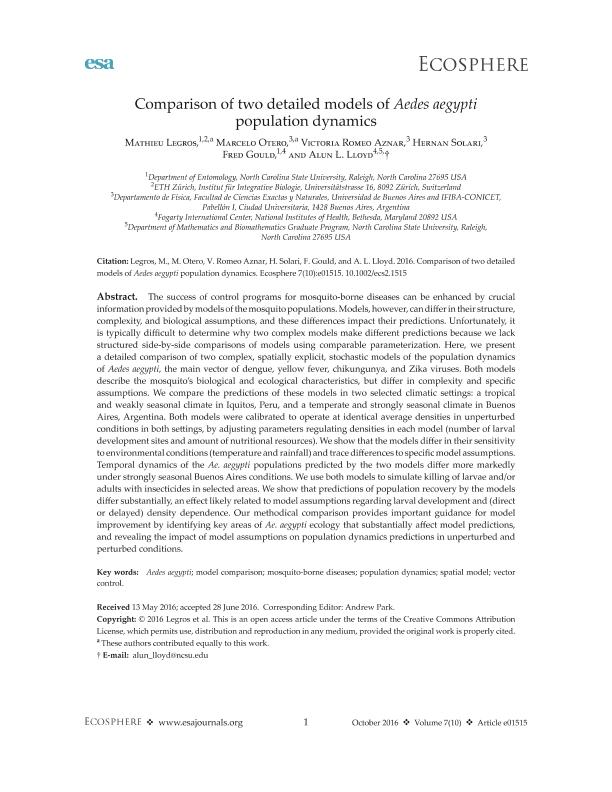Mostrar el registro sencillo del ítem
dc.contributor.author
Legros, Mathieu
dc.contributor.author
Otero, Marcelo Javier

dc.contributor.author
Romeo Aznar, Victoria Teresa

dc.contributor.author
Solari, Hernan Gustavo

dc.contributor.author
Gould, Fred
dc.contributor.author
Lloyd, Alun L.
dc.date.available
2018-06-18T13:44:36Z
dc.date.issued
2016-10
dc.identifier.citation
Legros, Mathieu; Otero, Marcelo Javier; Romeo Aznar, Victoria Teresa; Solari, Hernan Gustavo; Gould, Fred; et al.; Comparison of Two Detailed Models of Aedes aegypti Population Dynamics; John Wiley & Sons; Ecosphere; 7; 10; 10-2016; 1-19
dc.identifier.issn
2150-8925
dc.identifier.uri
http://hdl.handle.net/11336/48931
dc.description.abstract
The success of control programs for mosquito-borne diseases can be enhanced by crucial information provided by models of the mosquito populations. Models, however, can differ in their structure, complexity, and biological assumptions, and these differences impact their predictions. Unfortunately, it is typically difficult to determine why two complex models make different predictions because we lack structured side-by-side comparisons of models using comparable parameterization. Here, we present a detailed comparison of two complex, spatially explicit, stochastic models of the population dynamics of Aedes aegypti, the main vector of dengue, yellow fever, chikungunya, and Zika viruses. Both models describe the mosquito?s biological and ecological characteristics, but differ in complexity and specific assumptions. We compare the predictions of these models in two selected climatic settings: a tropical and weakly seasonal climate in Iquitos, Peru, and a temperate and strongly seasonal climate in Buenos Aires, Argentina. Both models were calibrated to operate at identical average densities in unperturbed<br />conditions in both settings, by adjusting parameters regulating densities in each model (number of larval development sites and amount of nutritional resources). We show that the models differ in their sensitivity<br />to environmental conditions (temperature and rainfall) and trace differences to specific model assumptions.<br />Temporal dynamics of the Ae. aegypti populations predicted by the two models differ more markedly under strongly seasonal Buenos Aires conditions. We use both models to simulate killing of larvae and/or adults with insecticides in selected areas. We show that predictions of population recovery by the models differ substantially, an effect likely related to model assumptions regarding larval development and (direct<br />or delayed) density dependence. Our methodical comparison provides important guidance for model improvement by identifying key areas of Ae. aegypti ecology that substantially affect model predictions, and revealing the impact of model assumptions on population dynamics predictions in unperturbed and perturbed conditions.<br /><br />
dc.format
application/pdf
dc.language.iso
eng
dc.publisher
John Wiley & Sons
dc.rights
info:eu-repo/semantics/openAccess
dc.rights.uri
https://creativecommons.org/licenses/by-nc-sa/2.5/ar/
dc.subject
Model Comparison
dc.subject
Mosquito-Borne Diseases
dc.subject
Population Dynamics
dc.subject
Spatial Model
dc.subject
Vector Control
dc.subject.classification
Otras Ciencias Biológicas

dc.subject.classification
Ciencias Biológicas

dc.subject.classification
CIENCIAS NATURALES Y EXACTAS

dc.subject.classification
Astronomía

dc.subject.classification
Ciencias Físicas

dc.subject.classification
CIENCIAS NATURALES Y EXACTAS

dc.title
Comparison of Two Detailed Models of Aedes aegypti Population Dynamics
dc.type
info:eu-repo/semantics/article
dc.type
info:ar-repo/semantics/artículo
dc.type
info:eu-repo/semantics/publishedVersion
dc.date.updated
2018-06-12T16:07:43Z
dc.journal.volume
7
dc.journal.number
10
dc.journal.pagination
1-19
dc.journal.pais
Estados Unidos

dc.journal.ciudad
Washington
dc.description.fil
Fil: Legros, Mathieu. University of North Carolina; Estados Unidos
dc.description.fil
Fil: Otero, Marcelo Javier. Universidad de Buenos Aires; Argentina
dc.description.fil
Fil: Romeo Aznar, Victoria Teresa. Universidad de Buenos Aires; Argentina
dc.description.fil
Fil: Solari, Hernan Gustavo. Universidad de Buenos Aires; Argentina. Consejo Nacional de Investigaciones Científicas y Técnicas. Oficina de Coordinación Administrativa Ciudad Universitaria. Instituto de Física de Buenos Aires. Universidad de Buenos Aires. Facultad de Ciencias Exactas y Naturales. Instituto de Física de Buenos Aires; Argentina
dc.description.fil
Fil: Gould, Fred. National Institutes of Health; Estados Unidos
dc.description.fil
Fil: Lloyd, Alun L.. National Institutes of Health; Estados Unidos
dc.journal.title
Ecosphere
dc.relation.alternativeid
info:eu-repo/semantics/altIdentifier/doi/http://dx.doi.org/10.1002/ecs2.1515
Archivos asociados
